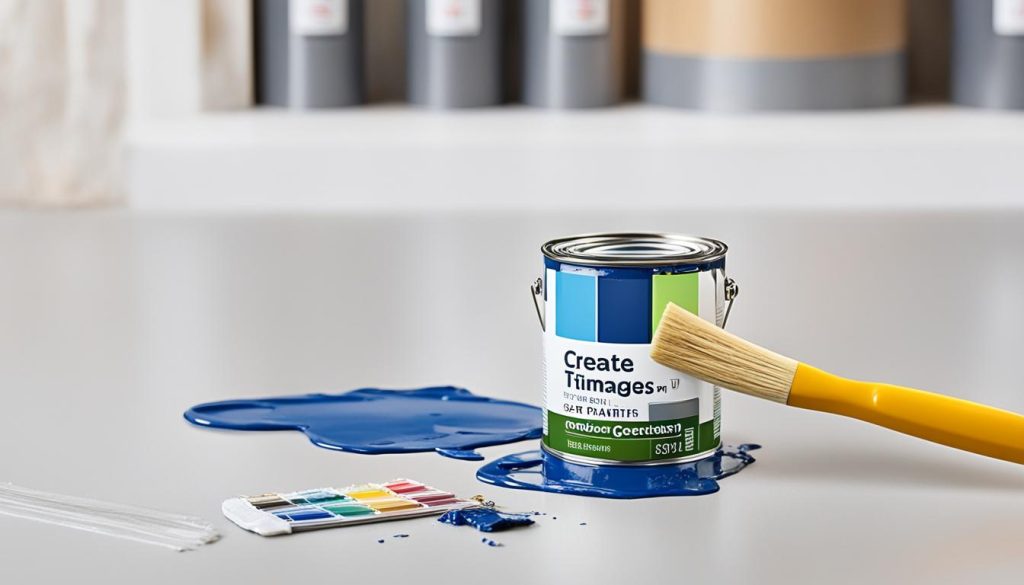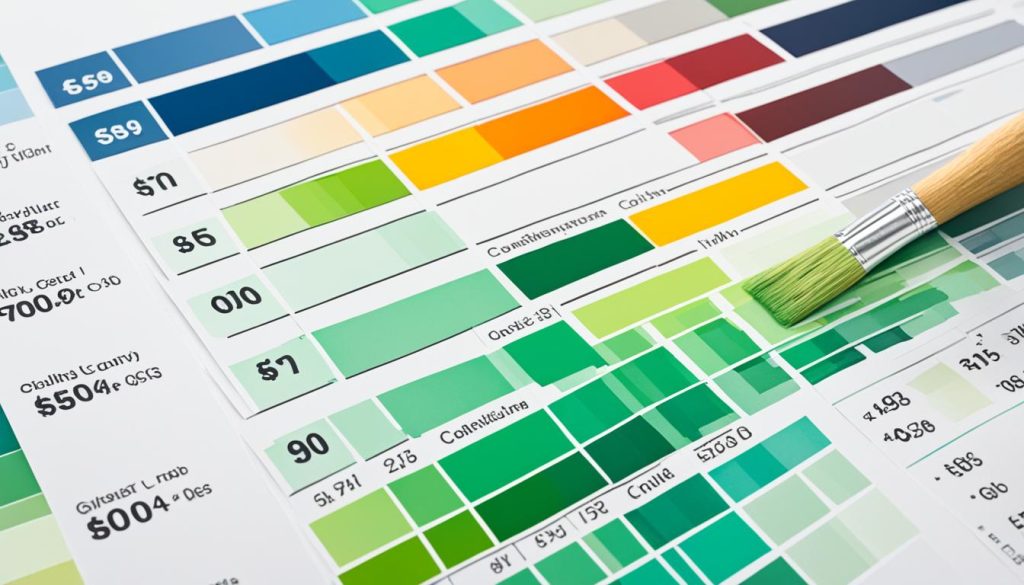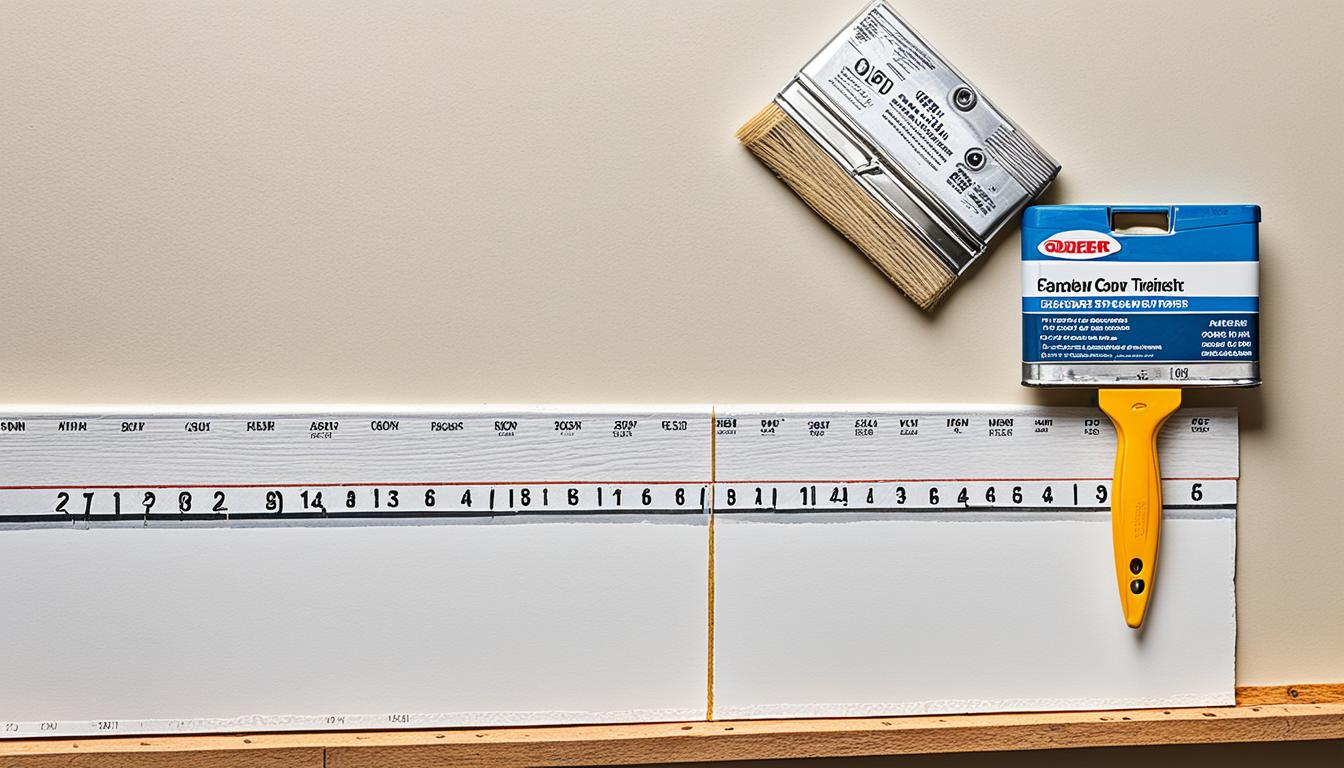Did you know that the cost to paint trim can vary significantly depending on various factors? From the type of trim to the location and size of the project, these factors can have a significant impact on the final price. In fact, according to sources, the cost to paint interior trim and baseboards ranges from $1 to $4 per linear foot, with a total cost of $500 to $2,000. For exterior trim, the cost can range from $1 to $4 per linear foot or $1,000 to $2,500.
These surprising costs highlight the importance of understanding the different factors that contribute to the overall cost of painting trim. By considering these factors and following a few tips, you can ensure that you make an informed decision regarding your trim painting project. Read on to discover the key factors to consider, average costs, and essential tips for successful trim painting.
Key Takeaways:
- The cost to paint trim can vary based on factors such as the type of trim, location, size of the project, and labor costs.
- Interior trim painting costs range from $1 to $4 per linear foot, while exterior trim painting costs range from $1 to $4 per linear foot.
- Additional costs may apply for specific types of trim, necessary repairs, and prep work.
- Consider hiring professional painters for intricate trim details or if unsure about the painting process.
- Following best practices, such as proper surface preparation and using multiple coats of paint, can help achieve a high-quality finish.
Cost Factors to Consider
When estimating the cost of painting trim, it is important to take several factors into consideration. These factors can greatly influence the overall cost and help ensure an accurate budget for your project. Here are some key cost factors to keep in mind:
- Type of Trim: The type of trim you have will impact the cost of painting. Some trims require more time and effort to paint than others, resulting in higher labor costs. For example, intricate or detailed trims may require more precise painting techniques and take longer to complete.
- Size of the Project: The size of the project, including the total linear footage of the trim, will also affect the cost. Larger projects will typically require more materials and labor, resulting in higher overall costs. It’s important to accurately measure the amount of trim that needs to be painted to get an accurate estimate.
- Location of the Trim: Trim located in hard-to-reach areas or areas with limited accessibility may require additional time and effort to paint. This can increase the labor costs associated with the project.
- Additional Services: Any additional services required, such as repairs or prep work, should be factored into the overall cost of painting trim. These services can add to the labor and material costs, so it’s important to discuss and budget for them accordingly.
Labor costs are another significant factor when considering the overall cost of painting trim. The labor cost per hour can vary depending on factors such as location and experience level of the painter. On average, labor costs range from $20 to $50 per hour.
Additionally, the cost per linear foot for trim painting can vary based on factors such as the type of trim and the type of paint used. It’s important to inquire about these specifics when obtaining estimates. Generally, the cost per linear foot for trim painting ranges from $1 to $5, depending on the complexity of the trim and the desired finish.
Example of Trim Painting Cost Calculation:
Let’s assume we have 200 linear feet of baseboard trim that needs to be painted. The labor cost per hour is $30, and the cost per linear foot for trim painting is $2. Here’s how the cost calculation might look:
| Cost Factor | Value |
|---|---|
| Total Linear Feet of Trim | 200 feet |
| Cost per Linear Foot | $2 |
| Labor Cost per Hour | $30 |
Using these values, we can calculate the cost as follows:
- Total Cost of Trim Painting: 200 feet * $2 = $400
- Labor Cost: (Total Linear Feet / Speed) * Labor Cost per Hour = (200 feet / 10 feet per hour) * $30 = $600
- Estimated Total Cost: $400 + $600 = $1,000
Keep in mind that this is just an example calculation and actual costs may vary. It’s always best to obtain quotes from professional painters to get an accurate estimate based on your specific project requirements.
Considering these cost factors and obtaining detailed estimates will help you plan and budget for your trim painting project effectively.
Average Cost to Paint Trim
When considering painting your trim, it’s important to have a clear understanding of the average cost involved. The national average cost to paint trim is approximately $1,000. However, keep in mind that this cost can vary depending on various factors such as the type of trim and the size of your project.
According to reliable sources, the average cost to paint 500 linear feet of trim ranges from $500 to $2,000. It’s essential to note that these figures are average costs, and your specific project requirements and regional factors can influence the actual cost.
| Project | Average Cost |
|---|---|
| 500 linear feet of trim | $500 – $2,000 |
As you can see, the cost range can vary significantly. To have a more accurate estimate for your specific trim painting project, it’s recommended to consult with professional painters who can assess your trim type, project size, and other relevant factors.

Exterior Trim Painting Cost
When it comes to painting exterior trim, there are several factors that can influence the cost. These factors include harder-to-reach areas and the use of different paint types compared to interior trim. The cost to paint exterior trim typically ranges from $1 to $4 per linear foot, with a total cost ranging from $1,000 to $2,500, depending on the size and complexity of the project.
To get a more accurate estimate, it’s essential to consider additional factors such as the type of exterior trim, design details, and accessibility.
Additional Costs for Eaves, Fascia, and Soffit
In addition to the cost of painting the exterior trim, you may also need to consider the cost of painting eaves, fascia, and soffit. These areas often require additional attention and may require extra time and materials to properly coat and protect.
The cost for eaves, fascia, and soffit typically ranges from $2 to $6 per linear foot, depending on the size and condition of these elements. It’s important to account for these additional costs when estimating the total cost of painting your exterior trim.
Exterior Trim Painting Cost per Linear Foot
| Exterior Trim Type | Cost per Linear Foot (Range) |
|---|---|
| Wood Trim | $1 – $4 |
| Aluminum Trim | $2 – $4 |
| Vinyl Trim | $1 – $3 |

With the right planning and consideration of these factors, you can estimate the cost of painting your exterior trim more accurately and ensure a beautiful and well-protected finish for your home.
Interior Trim Painting Cost
When it comes to painting the interior trim of your home, it’s essential to consider the cost implications. The total cost to paint interior trim typically ranges from $500 to $2,000 for an entire average-sized home. This cost is usually calculated based on the linear footage of the trim.
The average cost to paint interior trim is estimated to be between $1 and $4 per linear foot. However, the type of interior trim can impact the final price. Baseboards, crown molding, and chair rail may require additional costs, which can range from $1 to $5 per linear foot.
It’s important to note that if the interior trim to be painted is above 8 feet, there may be an extra charge of 25%. This additional cost is due to the additional equipment and effort required to reach and paint higher areas.
The overall cost of painting interior trim can also be influenced by factors such as the size and complexity of the project, as well as the type of trim and paint used. More intricate designs or customized trim may require additional time and expertise, affecting the final price.
To give you a better idea of the potential cost range, here is a breakdown of the estimated prices for painting different types of interior trim:
- Baseboards: $1 to $5 per linear foot
- Crown molding: $1 to $5 per linear foot
- Chair rail: $1 to $5 per linear foot
Keep in mind that these prices are approximate and can vary depending on various factors such as your location, the specific requirements of your project, and the rates of painting professionals in your area.
Next, let’s explore some additional costs and considerations to keep in mind when painting interior trim.
Additional Costs and Considerations
When it comes to painting trim, there are a few extra costs and considerations that homeowners should keep in mind. These aspects may affect the overall budget and planning for the project. Let’s take a closer look.
Prep Work and Repairs
Before starting the trim painting process, it’s essential to prepare the surface properly. This may include power washing to remove dirt and debris or making necessary repairs to damaged trim. The cost of prep work can vary depending on the extent of the repairs needed.
Hazardous Material Testing
In older homes built before 1978, there is a potential risk of lead-based paint. It’s crucial to conduct hazardous material testing to ensure the safety of everyone involved. If lead-based paint is found, it may require specialized removal or encapsulation techniques, leading to additional costs.
Consulting Professionals
When dealing with potentially hazardous materials or extensive prep work, it’s always a good idea to consult with professionals. They have the expertise and experience to handle any challenges that may arise during the trim painting process. Their guidance can help homeowners navigate these additional costs and ensure a smooth and successful project.
By considering these factors, homeowners can budget accurately and plan for any additional expenses that may arise when painting trim. It’s essential to prioritize safety and quality by addressing necessary repairs and conducting proper testing. Consulting with professionals can provide valuable insight and ensure a successful trim painting project.
DIY vs. Hiring a Professional
When it comes to painting trim, homeowners are faced with a choice: tackle the project themselves or hire professional painters. Both options have their pros and cons, so let’s take a closer look to help you make an informed decision.
DIY Trim Painting
If you’re the type of person who enjoys a good do-it-yourself project, painting trim can be a rewarding experience. Here are the advantages of taking on the task yourself:
- Savings on labor costs: DIY trim painting can save you money, as you won’t have to pay for professional painters.
- Flexibility and control: You have the freedom to choose the paint color, finish, and technique that suits your vision for your home.
- Personal satisfaction: Completing a DIY project can bring a sense of accomplishment and pride.
However, it’s important to consider the following factors before diving into a DIY trim painting project:
- Time and effort: Painting trim requires meticulous attention to detail and can be time-consuming, especially if you have a large area to cover.
- Skill and technique: Achieving a smooth, professional-looking finish may require skill and practice. If you’re not confident in your abilities, the end result may not meet your expectations.
- Tools and materials: DIY trim painting requires specific brushes, tape, and other supplies. Purchasing or renting these items adds to the overall cost.
Hiring Professional Painters
If you prefer to leave the job to the experts, hiring professional painters offers several advantages:
- Quality results: Professional painters have the expertise and experience to deliver a flawless finish that enhances the overall appearance of your home.
- Time savings: By hiring professionals, you can free up your time for other tasks and activities.
- Access to specialized tools and materials: Professional painters have access to high-quality paints, brushes, and equipment, ensuring a long-lasting and durable finish.
However, there are a few things to consider when hiring professional painters:
- Cost: Hiring professionals comes at an additional cost for labor, materials, and any necessary repairs or prep work.
- Limited control: While professional painters strive to meet your expectations, you may have less control over the outcome compared to doing it yourself.
- Scheduling and availability: Depending on the season and their workload, professional painters may have limited availability, potentially delaying your project.
Ultimately, the decision between DIY and hiring professional painters depends on your preferences, skill level, and budget. If you have the time, patience, and confidence in your abilities, DIY trim painting can be a cost-effective and rewarding option. On the other hand, if you value a professional finish and want to save time and effort, hiring professionals is the way to go.
Whichever route you choose, it’s important to weigh the pros and cons carefully to ensure a successful and satisfying trim painting experience.
| DIY Trim Painting | Hiring Professional Painters |
|---|---|
| Advantages | Advantages |
|
|
|
|
By carefully considering the advantages and disadvantages of each option, you can make an informed decision that best suits your needs and preferences.
Tips for Painting Trim
When it comes to painting trim, following best practices is key to achieving a high-quality finish. Whether you’re tackling the project yourself or hiring professionals, these tips will help you achieve the best results:
1. Proper Surface Preparation: Before painting, make sure to thoroughly clean and sand the trim to create a smooth and even surface. This will ensure better adhesion and a more professional-looking finish.
2. Fill Scratches and Divots: Use a lightweight compound to fill any scratches or divots in the trim. This will help create a seamless and flawless surface for painting.
3. Apply Multiple Coats: To achieve a durable and long-lasting finish, it’s important to apply multiple coats of paint. This will provide better coverage and a more even color distribution.
4. Consider Hiring Professionals for Intricate Trim: If your trim has intricate details or if you’re unsure about the painting process, it’s always a good idea to hire professionals. They have the expertise and tools to handle even the most challenging trim painting projects.
By following these tips, you can ensure a successful trim painting project that will enhance the overall look and value of your space.
